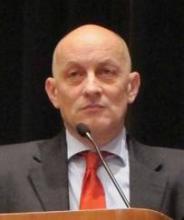SAN DIEGO – The risk of a secondary malignancy doubled in patients with newly diagnosed multiple myeloma treated with melphalan plus thalidomide or lenalidomide in a retrospective, pooled analysis of 2,283 patients.
Incidence rates per 100 persons per year of follow-up were 0.95 with high-dose melphalan (Alkeran) followed by lenalidomide (Revlimid) maintenance and 1.05 with melphalan and thalidomide. In comparison, rates were 0.40 with cyclophosphamide, lenalidomide, and dexamethasone and 0.42 with melphalan and no immunomodulatory drugs, Dr. Antonio Palumbo reported at the annual meeting of the American Society of Hematology (ASH).
At 4 years of follow-up, second cancers were diagnosed in 48 (2.1%) of the 2,283 patients enrolled in nine experimental trials of the European Myeloma Network. There was consistent evidence of an increase in late events over time.
"I do not want to underestimate the issue," Dr. Palumbo said. "There is a signal, but the first conclusion is caution. When you come to 48 cancers versus 2,200 patients, by chance many things may happen."
He noted that the risk of multiple myeloma progression is between 10 and 15 times higher than the diagnosis of a second cancer, and suggested that the emphasis on second cancers may be overshadowing the risk of death due to toxic effects and infections.
Of the 48 secondary cancers, 8 of the 10 hematologic malignancies and 8 of the 38 solid tumors were fatal. In contrast, there were 124 toxic deaths (8.6%) and 49 infective deaths (3.4%) among 1,435 patients given the combination of melphalan-prednisone-thalidomide or bortezomib (Velcade)-melphalan-prednisone, said Dr. Palumbo, chief of the myeloma unit at the University of Torino (Italy).
"We take it for granted that with chemo we have some toxic effects," he said in an interview. "We should increase our alert of our combinations, and not focus solely on the second cancers."
Session co-moderator Dr. Meral Beksac, with Ankara (Turkey) University, said the Italian data suggest caution and greater vigilance regarding routine cancer screenings among multiple myeloma patients, but would not change her treatment approach.
"Dr. Palumbo has shown very beautifully that the benefits you achieve in terms of the long-term myeloma effect outweigh the risk of secondary malignancies," she said in an interview. "Personally, I think we must plan to avoid alkylating agents when we now have these better agents."
Preliminary data from three trials showing a fourfold increase in secondary cancers in multiple myeloma patients treated with lenalidomide as maintenance therapy or in combination with melphalan prompted investigations into the safety of lenalidomide in the United States and Europe in 2011.
The European Medicines Agency concluded in September that the benefits of lenalidomide continue to outweigh the risks within the approved setting of relapsed multiple myeloma, but recommended that a warning be added on the risk of second cancers. The U.S. Food and Drug Administration review is ongoing, and includes the risk for thalidomide, since lenalidomide is an analogue of thalidomide.
Although the development of acute myeloid leukemia (AML) following multiple myeloma was observed decades ago, the underlying mechanisms remain unclear. Swedish researchers recently reported that the risk of AML and myelodysplastic syndromes is 11.5-fold higher in multiple myeloma patients than in the general population, even before the introduction of novel agents (Blood 2011;118:4086-92). In addition, the risk of AML/MDS was eightfold higher in patients with monoclonal gammopathy of undetermined significance (MGUS), even though none of the MGUS patients developed multiple myeloma, according to session co-moderator Dr. Sigurdur Y. Kristinsson, who was a coauthor of the Swedish study.
"Even those people that never develop the disease have an increased risk of AML and MDS, so it shows that it’s not only the treatment that we’re giving, but it’s also an inherent susceptibility," Dr. Kristinsson, with the Karolinska Hospital and Institute in Stockholm, said in an interview.
Work is ongoing to identify multiple myeloma patients at an increased risk of second cancers, thereby allowing clinicians to tailor therapy to reduce risks. A separate poster presentation at the ASH meeting reported that higher risk of second cancers was associated with older age, male sex, and radiation and/or surgery among roughly 29,250 multiple myeloma patients in the Surveillance, Epidemiology, and End Results (SEER) database.
Subgroup analysis of the pooled Italian data did not identify specific subgroups at greater risk, Dr. Palumbo said. The incidence rate was higher at 1.13 per 100 person-years for patients given melphalan-lenalidomide vs. 0.76 per 100 person-years for patients treated with autologous stem cell transplantation and lenalidomide (median age 68 years vs. 59 years, respectively).


